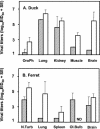Isolation and characterization of avian influenza viruses, including highly pathogenic H5N1, from poultry in live bird markets in Hanoi, Vietnam, in 2001
- PMID: 15767421
- PMCID: PMC1061558
- DOI: 10.1128/JVI.79.7.4201-4212.2005
Isolation and characterization of avian influenza viruses, including highly pathogenic H5N1, from poultry in live bird markets in Hanoi, Vietnam, in 2001
Abstract
Since 1997, outbreaks of highly pathogenic (HP) H5N1 and circulation of H9N2 viruses among domestic poultry in Asia have posed a threat to public health. To better understand the extent of transmission of avian influenza viruses (AIV) to humans in Asia, we conducted a cross-sectional virologic study in live bird markets (LBM) in Hanoi, Vietnam, in October 2001. Specimens from 189 birds and 18 environmental samples were collected at 10 LBM. Four influenza A viruses of the H4N6 (n = 1), H5N2 (n = 1), and H9N3 (n = 2) subtypes were isolated from healthy ducks for an isolation frequency of over 30% from this species. Two H5N1 viruses were isolated from healthy geese. The hemagglutinin (HA) genes of these H5N1 viruses possessed multiple basic amino acid motifs at the cleavage site, were HP for experimentally infected chickens, and were thus characterized as HP AIV. These HA genes shared high amino acid identities with genes of other H5N1 viruses isolated in Asia during this period, but they were genetically distinct from those of H5N1 viruses isolated from poultry and humans in Vietnam during the early 2004 outbreaks. These viruses were not highly virulent for experimentally infected ducks, mice, or ferrets. These results establish that HP H5N1 viruses with properties similar to viruses isolated in Hong Kong and mainland China circulated in Vietnam as early as 2001, suggest a common source for H5N1 viruses circulating in these Asian countries, and provide a framework to better understand the recent widespread emergence of HP H5N1 viruses in Asia.
Figures




References
-
- Banks, J., E. C. Speidel, P. A. Harris, and D. J. Alexander. 2000. Phylogenetic analysis of influenza A viruses of H9 hemagglutinin subtype. Avian Pathol. 29:353-360. - PubMed
-
- Bender, C., H. Hall, J. Huang, A. Klimov, N. Cox, A. Hay, V. Gregory, K. Cameron, W. Lim, and K. Subbarao. 1999. Characterization of the surface proteins of influenza A (H5N1) viruses isolated from humans in 1997-1998. Virology 254:115-123. - PubMed
-
- Bridges, C. B., W. Lim, J. Hu-Primmer, L. Sims, K. Fukuda, K. H. Mak, T. Rowe, W. W. Thompson, L. Conn, X. Lu, N. J. Cox, and J. M. Katz. 2002. Risk of influenza A (H5N1) infection among poultry workers, Hong Kong, 1997-1998. J. Infect. Dis. 185:1005-1010. - PubMed
-
- Cameron, K. R., V. Gregory, J. Banks, I. H. Brown, D. J. Alexander, A. J. Hay, and Y. P. Lin. 2000. H9N2 subtype influenza A viruses in poultry in Pakistan are closely related to the H9N2 viruses responsible for human infection in Hong Kong. Virology 278:37-41. - PubMed
Publication types
MeSH terms
Substances
LinkOut - more resources
Full Text Sources
Other Literature Sources
Medical
Research Materials
Miscellaneous

